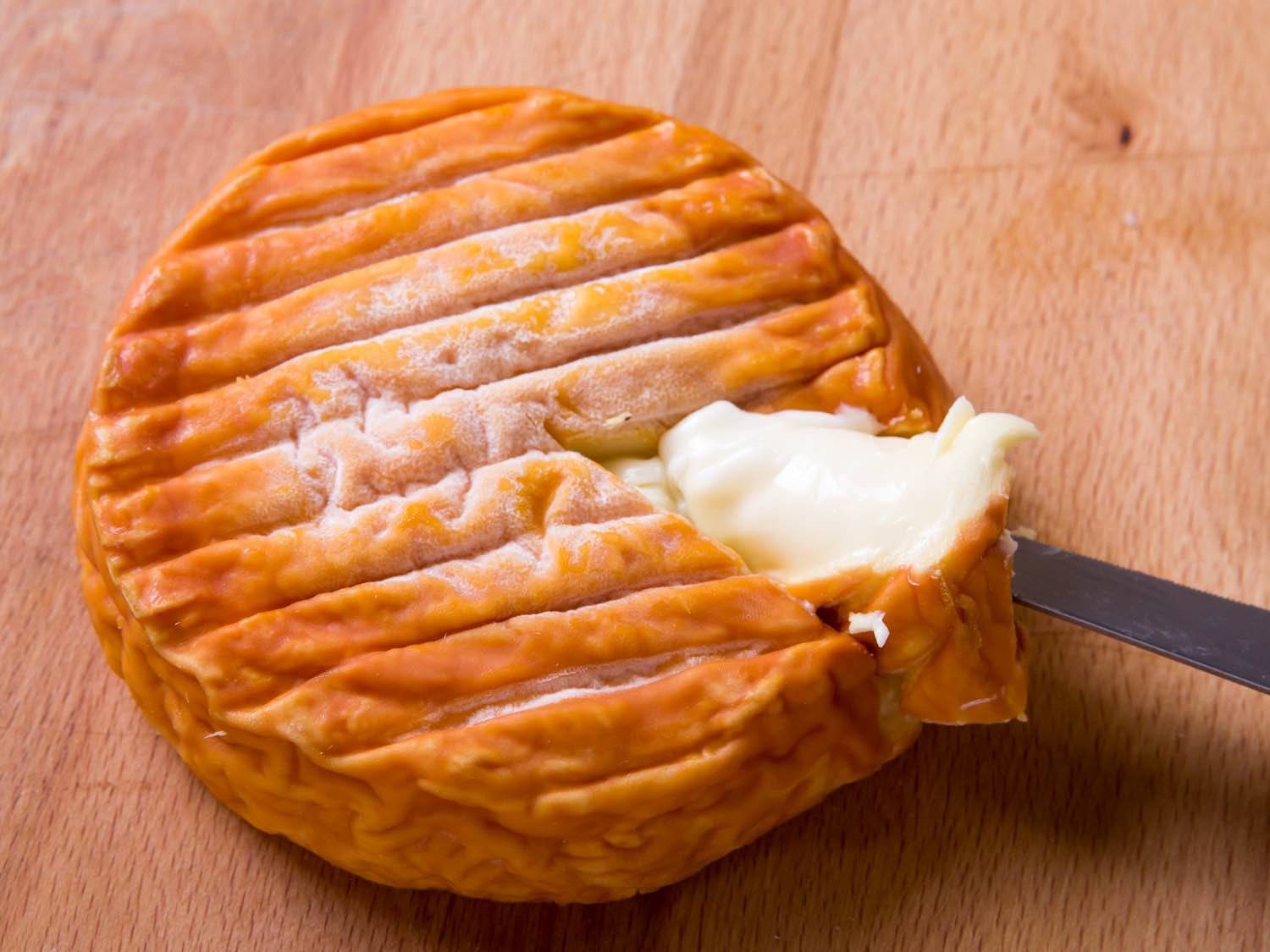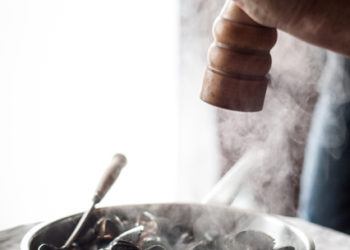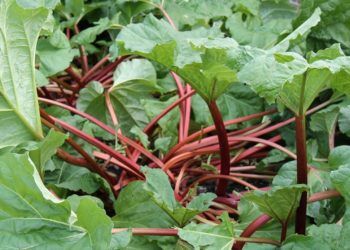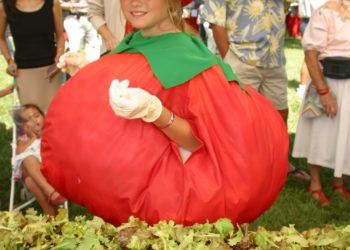From Maine to California, chefs and sommeliers are recognizing what certain cultures have understood for centuries, that fermented grain-based beverages flatter and are flattered by cheese, which is itself a product of grain and fermentation.
At Vignola in Portland, Maine, chef Lee Skawinski features dozens of craft beers and Belgian-style ales, in addition to what has been acclaimed as the best selection of wines in the state. Earlier this year when he developed pairings for a group of French cheeses chosen by Max McCalman, maitre fromager at Manhattan’s Artisanal Cheese Center [now closed], he defied conventional wisdom by pairing each classic cheese with beer. Sure, it was a ploy by Cheeses of France to capture the Superbowl crowd but the pairings (which you can see here) more than stand up to even the most particular palates.
“A big red wine is the least successful option with cheese,” Jim Rollston, sommelier of Cyrus Restaurant [now closed] in Healdsburg, says.
Cyrus includes a cheese course on its tasting menu; six cheeses–along with house-made breads, panforte, seasonal and dried fruits and nuts–are served from a cart that includes more than a dozen New World artisan and European classic cheeses. Guests can make their own selections or leave it up to their server.
Without a sommelier to guide them, nearly all diners at Cyrus choose a monster red, a huge tannic fruit bomb with lots of jammy intensity, to go along with the cheese. But many customers take one of the two pairing options the restaurant offers, which puts Rollston or his assistant, Chase DuBay, table side at every course. When it comes time for cheese, they introduce the possibility of beer.
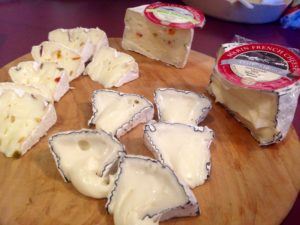
Two cheeses from Marin French Cheese Co. in Petaluma
“Whoever presents this option,” Rollston emphasizes, “must do it with passion and offer compelling reasons why it works.”
Most guests go with the suggestion and not a single diner has been less than thrilled with the results. Not only do they have a delicious experience; they learn something.
“The beer goes with every cheese!” they exclaim, completely surprised by the delicious versatility of the match.
The Problem with Wine
When wine is paired with cheese, it is not the cheese that suffers most.
“Pairing red wine with cheese never makes a wine taste better,” Rollston says.
“A red wine may occasionally enhance a cheese but that cheese will never ever push a wine to a new dimension.”
The lack of harmony, a failure to soar, you could say, is a function of butterfat; it prevents the palate from detecting the nuance and subtlety of red wines. Tannins fight with the fat and do not, as some mistakenly believe, refresh the palate. As any amateur or professional wine taster knows, tannins shut down the plate. Additionally, acid in cheese will alter the taste of a wine while a salty cheese can make a red wine seem bitter or flabby.
Why do this to a fine wine? Enjoy cheeses with beverages that welcome them and save those premium cabs and syrahs for other occasions.
It’s In the Bubbles
Beer, with its pleasing effervescence, functions much as Champagne does. Both cut through butterfat, allowing the flavors of the cheese and the beverage to dance lightly upon the tongue.
The common explanation for this is that the effervescence cleanses and refreshes the palate but Jim Javenkoski, who is ale-vangelist for Arcadia Brewing Company in Battle Creek, Michigan, puts it differently.
“The cleansing of the palate is minimal if it exists at all. Effervescence provides stimulation of the trigeminal nerves.” Jim Javenkoski says. Cheese is dense and rich on the palate, he explains, and the effervescence provides additional physical stimulation that still wine cannot contribute. Simply put, one branch of the trigeminal nerves transports physical sensations– temperature, pressure and such–from the mouth to the brain.
According to Javenkoski, who holds both a bachelor’s degree and a doctorate in food science, beer and cheese provide a fuller range of taste sensations than wine and cheese. With beer, all five sensations–salty, sweet, sour, bitter and umami–are engaged. Beer brings sour and bitter to the duo; cheese accounts for salty and umami; both contribute degrees of sweetness. The spices used in many beers, especially the fruit beers of Belgium, add additional stimulation.
“With beer and cheese,” Javenkoski emphasizes, “there is a full sensory gestalt that does not happen with wine and cheese”
Long Traditions and the Myth of Terroir
One need not look far to find a tradition of beer and cheese. Take Ploughman’s Lunch, that classic of British pubs. Although there are as many variations as there are pubs, Plougman’s Lunch always includes bread, pickles, cheese–most often a chunk of Cheddar and a piece of Stilton or some other local cheese–and always comes with a pint of ale. Almost always, anyway; now and then you may find that the house specialty is hard cider; otherwise, it’s beer, never wine.
In Belgium, a country with a long tradition of grain agriculture that extends back centuries, farm workers drank saison, a hardy farmhouse ale, five hundred years ago. Because water was not potable, saison was a primary family beverage in the hot summer and fall because it had enough alcohol to stand up to the heat without spoiling.
Today, saison-style ales are enjoying a resurgence of popularity, especially in the United States. This is good news for both beer lovers and cheese lovers.
Both Belgium and the UK have long histories of dairy farming, including cheese making, with traditional cheeses developed centuries ago. Does this mean that we should look to beer and cheese from the same location for the very best pairings?
Not according to Max McCalman.
As dean of curriculum at the Center, he oversees dozens of classes about cheese, including monthly tastings that focus on beer and cheese.
“One of the biggest misconceptions I hear,” he says, “is that the cheese and the beverage should come from the same place to be successful. But this notion of terroir is overplayed. Terroir shapes the outcomes of the cheese but not of the pairing. There is so much more that goes into cheese making and into the making of the beverage that give them their character.”
What McCalman is saying is that the art of pairing is neither reductive nor objective. While pairing regional products often yields a compelling resonance, you can’t turn it into a formula or rely on a list of rules.
“So many variables come into play in shaping successful matches,” he says, “and even the order that one tastes has an influence.”
A Moment In Time
In the end, any pairing–this particular cheese with that particular beer or any food with any beverage–is ephemeral, a snapshot of a moment in time.
Those pairings that soar, that bring transcendent delight to the palate, are more than the objective, measurable qualities of a food and a beverage. We all have our own palates, our own preferences, references, memories and biases, our own body chemistry, and, let us not forget, our own trigeminal nerves.
There are certain general guidelines that lead us in potentially pleasurable directions–and isn’t it pleasure that we are seeking as we search for the perfect pairing?–and if there is one to take away from this discussion it is that beer and cheese are happy companions. If you haven’t given them a chance before now, you probably should at least think about it.
Clark Wolf, author of American Cheeses: The Best Regional, Artisan, and Farmhouse Cheeses (Simon & Schuster, 2008), makes a wise point when he suggests that at the end of a meal cheeses generally go just fine with whatever beverages are left on the table.
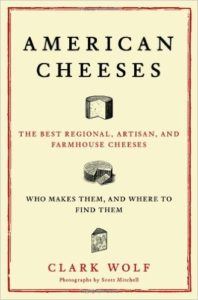
Clark Wolf’s ode to America cheese, required reading for all cheese lovers.
“The end of a long, happy evening,” he writes, “is not a time to struggle with deep thinking and big choices.”
But if you need another drink, why not step out of the box–and out of the wine glass–and into a flagon of beer?
This story originally appeared in Wine Enthusiast Magazine in 2009.


